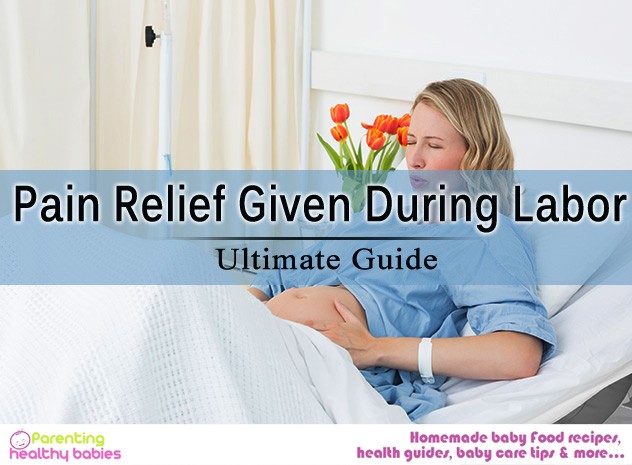Labor is a painful, confusing and seemingly endless process, at least to the pregnant mother. But mothers bear it and somehow grind through it only to hold, feel, touch and behold the infant, the result of her 9 months of pregnancy. But the pain often reaches a crescendo; it becomes unbearable at times. That makes it painfully difficult for even the most feisty women. She needs something that will ease the feeling of pain.
Read More: Prolonged Labor: Risks and Treatment
Tips for Pain Relief During Labour
In the extreme cases the doctor may advise epidural injection or other analgesic or anesthetic treatment for her. But in general, there are some natural techniques that can help you to get some relief from labor pain.
1} Tell your husband to apply hot and cold compress
Hot compress on lower back and lower abdominal region is helpful in easing the pain to some extent. Why this works? You are in pain since the muscles are tense and are stretched to the extreme, especially the perineum. A hot compress will ease the tensed muscles to some extent and that will ease the pain. However, continuous hot compress may not work very well. Do apply some cold compress sometimes too. Though a cold compress can constrict the muscles and increase the tension, it has another effect which may work for some time. A cold compress can numb your senses.
If you apply cold compresses for some time blood flow to the muscles will get reduced and that will in turn reduce the feeling of pain. So if you find that hot compress is not working after some time you can go with some cold compress to numb the senses and reduce pain. Intermittent hot and cold compress is a good idea not only to bring down the sense of labor pain, but also for shortening labor. This is because hot compress is known to induce labor. In fact, studies have attested to this fact.
Read More: 11 Signs of Labor You Must Know
2} Your husband needs to practice perineal massaging techniques on you
Massaging is a time tested technique for pain relief. Perineal massage is an effective solution to reduce the feeling of labor pain. The Perineum is the area between the vagina and the anus. This area gets stretched to the maximum during labor and that adds to the intensity of pain. It has been observed that massaging this area a few days prior to delivery may reduce labor pain. In fact, it is seen that women who have undergone perineal massage have a more humble experience about labor pain.
They have reported less pain emanating from the perineum. Your husband is the best person to give you this massage. The technique is to start it around two to three weeks before the due date. It needs to be done three to four days a week. By massaging regularly the perineal area can get used to being stretched and you will feel less stressed during labor.
Read More: 21 Effective Ways to Induce Labor at Home
3} Practice a definite and comfortable pattern of breathing
Right breathing technique during labor can help the relief labor pain to some extent. Whether it is deep breathing or shallow breathing, it should have the net effect of calming and relaxing the body. You can find out your own convenient pattern of breathing weeks before the due date. But your breathing should not be at an uncomfortable pace and it should not be something that is forced on your body. Your body should be comfortable with it and feel relaxed. In fact, steady breathing in a comfortable rhythm can be a stress buster in many circumstances including labor.
Read More: 11 Reasons for a Prolonged Labor
4}Get into a bath tub with warm water
You can overcome some pain if you get into the bathtub or a birth pool. It is more effective if the water is warm. Warm water itself has a calming effect on the nervous system. The hormones that help people with pain relief may get a boost if you are in a warm water pool. Moreover, when you are sitting in warm water your cervix dilates better and the stage of labor becomes shortened. However, such techniques are generally done under medical supervision.
Another point to remember is that the water should be just warm and not hot. Hot water may interfere with your baby’s health. Submerge yourself into the water to the extent you feel comfortable. If you feel comfortable with the bump completely under water go for it. If not, sit in a way that some portion of the bump is above water. After all it is meant to be a relaxing technique, not a rigid rule.
5} You can practice hypnotherapy
This is nothing but taking your attention away from labor and focus on something else. This is a kind of meditative technique, and you need to learn and master it few weeks before the due date. As and when you can apply this technique successfully, you may be able to get your attention away from the process of labor. This will ease the pain to a great degree. Your anxiousness about the labor process would come down and you would feel more relaxed. But to practice and learn it you need to take the help of a therapist. They are experts in such techniques. But, again, do this few weeks before the due date, otherwise it may be too late to practice and master it.
Read More: 11 Things You Should Know about Preterm Labor
6} Take a warm water shower
Warm water offers comfort, and taking a shower is relaxing for the mind and the body. If you take a warm water shower you may feel relaxed to some extent. However, you should use warm water shower only after the cervix has dilated properly so that the baby can come out. This is because warm water has the property to induce labor. Moreover, the water should only be comfortably warm and not hot. Hot water may not be good for the baby.
7} Call an acupuncture practitioner
Some acupuncture therapists are able to reduce pain sensations with the help of acupuncture. Though this is not a time tested method, some women do feel relaxed with acupuncture. These practitioners use definite points in the nervous system to suppress the feeling of pain. The moot point is to have perfect knowledge about the areas on which the needles need to be pricked in order to provide pain relief. It depends on the knowledge and experience of the practitioner to find out the appropriate points for labor pain relief.
Read More: 11 Signs That You are in Labor
The right pain relief technique may be different for different women. However, methods such as massaging, breathing and hot and cold compress are techniques that anybody can practice. Other techniques call for medical supervision.
References
https://www.ncbi.nlm.nih.gov/pmc/articles/PMC3872865/
https://hellodoktor.com/pregnancy/giving-birth/common-types-labor-pain-relief/













